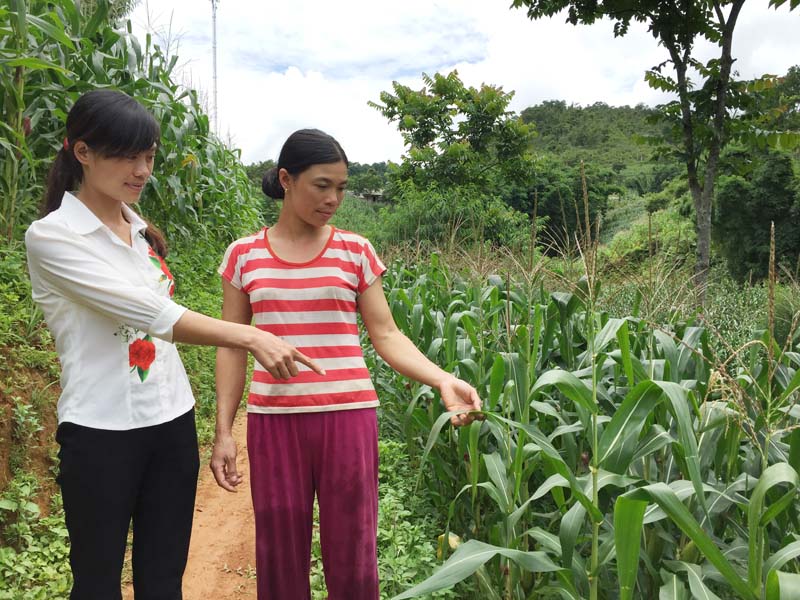
(HBO) – Ms. Pham Thi Phuong, the Chairman of the Women Union of Tan Lac district, said: "Bringing annual crops into the area of inefficient rice cultivation in Tan Lac district in the period of 2014-2020" is the policy stated clearly in the Resolution No. 12, April 18, 2014 by the District Party Committee. Implementing the guidelines of the district, the Women Union in the district has effectively carried out the emulation movement of "Women run good economy, positively transforming the structure of plants and animals effectively", thereby, this can bring stable income and improve the living conditions for the families of the members of Women Union.

The staff of Bac Son Commune Women Union
(left) is giving advice to the members to change the area of inefficient cultivation
into higher productive and more efficient planation.
Ms. Pham Thi Phuong added: In order to
effectively change the crop structure in the spirit of the Resolution of the
District Party Committee, the District Women Union has directed and promoted
the emulation movement of "Women run good economy, positively transforming
the structure of plants and animals effectively". In four years
(2014-2018), the Unions at all levels in the district has coordinated with the
Agricultural and Forestry Station, the companies and enterprises have organized
132 training courses , transferring technology and science of plantation,
bringing new seedlings into cultivation, using fertilizers, pesticides, care
and pest control, etc. As a result, over 7,780 members have been trained to
enhance their knowledge. On the basis of the knowledge provided, women have
learned to apply into production, actively participate in projects, economic
development projects of the district. In addition, women bravely borrowed
capital from the bank for investment in economic development with high
efficiency .There are many members who are active, creative and brave to take
the lead in crop conversion and make use of the advantages of each region to
get rich legitimately and become a good model of running excellent economy.
According to data from the Hoa Binh Provincial Party Committee, the industrial production index for the first six months of 2025 is estimated to have increased by 20% compared to the same period last year. This marks the highest year-on-year growth rate for this period since 2020.
In the first six months of 2025, Hoa Binh province’s export turnover was estimated at 1.145 billion USD, marking an 18.11% increase compared to the same period in 2024. Import turnover was estimated at $ 804 million, a 17.15% increase, which helped the province maintain a positive trade balance.
The lives of the ethnic minority farmers in Tan Lac district have gradually improved thanks to the new directions in agricultural production. This is a testament to the collective strength fostered through the professional associations and groups implemented by various levels of the district’s Farmers’ Union.
With the motto the "product quality comes first,” after nearly one year of establishment and operation, Muong village’s Clean Food Agricultural and Commercial Cooperative, located in Cau Hamlet, Hung Son Commune (Kim Boi district), has launched reputable, high-quality agricultural products to the market that are well-received by consumers. The products such as Muong village’s pork sausage, salt-cured chicken, and salt-cured pork hocks have gradually carved out a place in the market and they are on the path to obtaining the OCOP certification.
In the past, the phrase "bumper harvest, rock-bottom prices" was a familiar refrain for Vietnamese farmers engaged in fragmented, small-scale agriculture. But today, a new spirit is emerging across rural areas of Hoa Binh province - one of collaboration, organisation, and collective economic models that provide a stable foundation for production.
Maintaining growing area codes and packing facility codes in accordance with regulations is a mandatory requirement for agricultural products to be eligible for export. Recently, the Department of Agriculture and Environment of Hoa Binh province has intensified technical supervision of designated farming areas and packing facilities to safeguard the "green passport" that enables its products to access international markets.



